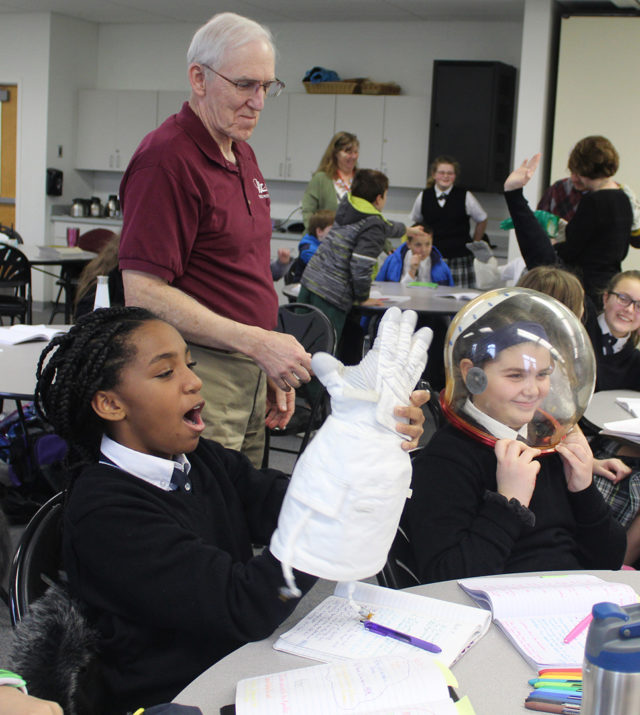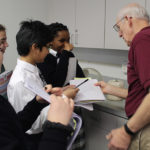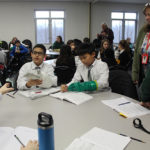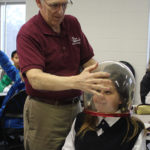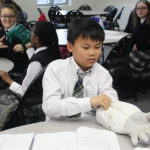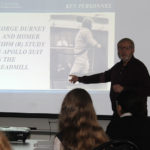DOVER – Two neighbors talking to each other about, of all things, the Pittsburgh Steelers, led to the sixth grade at Holy Cross School getting a chance to interact with three men who played a role in the United States’ space program. The men, all parishioners at Holy Cross, worked for ILC Dover, the company that designed and made spacesuits, including the Apollo 11 mission.
Apollo 11, which took place in 1969, was the United States’ first flight into space that landed people on the moon. Neil Armstrong, the commander, and Buzz Aldrin, the lunar module pilot, landed on the moon on July 20, 1969, and stepped on to the surface six hours later, on July 21. It is the subject on an upcoming documentary.
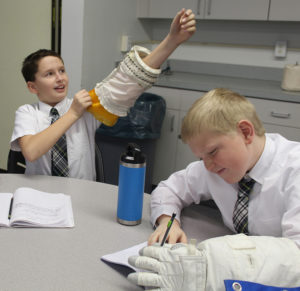
Jim Clougherty, Tom Corbeil and Tom Pribanic visited Holy Cross on Jan. 29, taking turns describing various aspects of the work done by ILC Dover. The students listened closely, throwing their hands up whenever a fact escaped them. It was a unique show and tell, which included several pieces of equipment made by ILC Dover, along with photographs and news articles.
Their visit came about after Pribanic and Holy Cross teacher Patricia Guido, who are neighbors, were talking one day about being fans of the Pittsburgh Steelers since both are from western Pennsylvania. The conversation turned to what each did, and Pribanic mentioned that he and the other two retirees had their presentation.
Pribanic led off with some history of the company. ILC Dover – a branch of the International Latex Corp. – had made flexible attack boats, life rafts and canteens during World War II. The company had become known as Playtex and was better known for manufacturing ladies’ undergarments, but the founder, Abram Spanel, wanted in on the space program, Pribanic said. The company threw its hat in the ring and became the center of the spacesuit world.
“NASA looked at all the suits, and ILC won it. There’s a biblical theme in this – David and Goliath,” he said.
Clougherty, an engineer, talked about some of the technical aspects. The astronauts needed special suits because “there is no pressure (in space). It’s a vacuum in space. It’s like sucking air out of a can,”
Without air pressure, a human being cannot survive. Besides exposure to extreme temperatures and a lack of oxygen, micrometeroroids – space dust – move at a fast pace and could pierce the skin.
“The spacesuit is its own spaceship,” Clougherty explained, with cooling and heating capabilities, communication equipment and other items to keep the astronauts alive and productive.
The Dover office, which is now the location of a charter school, saw lots of testing and messing around with gadgets, Corbeil explained. The materials in the various parts of the suit had to withstand extreme wear and tear.
“We had to make sure it would last the duration of the mission,” he said.
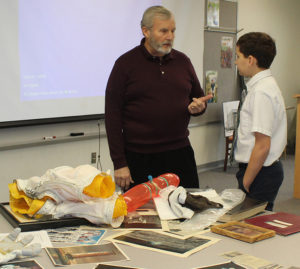 Each of the suits required 77 different measurements from the astronauts, Pribanic said, and each man had three of them – a training suit, a flight suit and a backup. The seamstresses in Dover worked day and night to complete the work.
Each of the suits required 77 different measurements from the astronauts, Pribanic said, and each man had three of them – a training suit, a flight suit and a backup. The seamstresses in Dover worked day and night to complete the work.
“They were central to the program,” he said.
When the astronauts would come to Dover, he added, they made sure to visit the seamstresses and give them autographed photographs.
Corbeil showed the students parts of the spacesuit that they had brought with them. The gloves provided insulation, and the palms had a metal screen sewn into them for protection. The fingertips were made of rubber to help them grip things, but the flexibility wasn’t the best. The visors in the helmets had a gold coating to protect the astronauts’ eyes.
He held a cross section of the body of a spacesuit showing each of its layers. They included nylon and Kevlar; a type of aluminum foil; rubber; and a layer that contained small tubes that carried water to help keep the astronauts cool.
The day concluded with the students getting to try on the various items Pribanic, Corbeil and Clougherty had brought with them. Gloves, sleeves and helmets made their way around the room. Some of the students were so impressed, they asked the trio for autographs.
ILC Dover is now headquartered in Frederica. The company has six locations around the world and continues its work in the aerospace industry.


